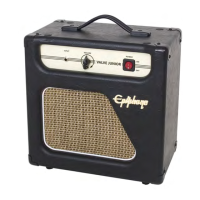46 Epiphone Valve Jr.•Mercury Upgrade Kit
ThisprojectanditsdocumentationistheresultoftechnicalinvestigationsmadebytheengineeringstaffofMercury Magnetics.Thedisclosureoftheinformationhereinmaypertaintoproprietaryrightsand
thefurnishingofthesedocumentsdoesnotconstituteanexpresedorimpliedlicensetousesuchmaterials.
2. Digital multi-meter.Capableofreading500
voltsDC.
3. Capacitor discharge tool.Ajumperwire
consistingofalligatorclipsontheends,witha
resistorinseriesinthemiddleofthejumper.
4. Needle nose pliers.Withverygoodinsulation
onthehandlesforholdingthealligatorclipsof
thecapacitordischargetool.
Alwaysmakesureyourtoolsareingoodcondition.
Ifthere’sanyquestion,replacethem.Cracked
insulationisoneoftherstthingstocheck,and
checkoften.
TurnthepowerswitchOFF,andplacethestandby
switchintheONposition.Thisisn’tthesameas
havingyouramp“onstandby.”
Alwaysunplugtheampfromthewall.Unplugging
fromthewallwillnotdraintheltercapacitors
completely,butagainthisisforourownsafety.
Unpluggingistheequivalentto“lockingout”before
workingonadownedmachine.
Becauseltercapsarealmostalwaysofthe
electrolytictype,they’re“polarized”andtherefore
haveapositiveandnegativeend.Wecanidentify
thepositiveornegativeendsbylookingforthe
“polarityindicator”printedonthecap’sside.
Ourrstobjectiveistocheckforresidualvoltage
withamulti-meter.Insomecasesmostofthe
voltagemayhavealreadybeendrained.Many
amplierswillincorporate“bleeder”resistors,which
willdrainthecapacitorchargeautomaticallyin
afewminutesaftertheampisturnedoff.Don’t
dependonthisresistortodothejob.Neverassume
thecapshavebeendrainedtoasafelevelwithout
checkingwithareliablemulti-meter.
Here’sacoupleofwaystomeasuretheresidual
voltagecontainedintheltercapacitors.Notethat
thesearealsoequallyvalidfordrainingthecaps:
1. Across the capacitor.
2. From the positive side of the cap to the
chassis.Thisisessentiallythesameas
draining“across”thecapssincethenegative
sideisatthesameelectricalpotentialasthe
chassis.
3. From the chassis to a tube pin.Thiscanbe
doneatpin3ofanypowertube,orpins1or
6ofanypreamptube.Byshortingthechassis
tothecorrectpinthecapswillbeforcedto
drainthroughtheplateloadofthattube.This
preventssparkingfromhighcurrent.
IMPORTANT NOTE, HOW NOT TO DO IT: Inold
electronicsbookstheytellyoutouseascrewdriver
withaninsulatedhandletoshortoutthecaps.
“Shorting”withascrewdriverwillalmostinstantly
drainthecapstozerovolts,causingsparksfrom
highcurrent.Thisisnotacceptable.Ifthereare
severalhundredvoltsstoredinthecaps,be
preparedforanicesizedspark.Itwillmostlikely
leaveablackmarkonthechassis,andinextreme
cases,partiallyweldthescrewdrivertothechassis.
Now we’re ready to start testing and
discharging
Setyourmulti-metertoreadDCvoltage.Adjust
themeter’srangesothatit’sabove500volts.Clip
theblackleadofyourmulti-metertothechassis.
Usingonlyonehand,withtheotherhandfarfrom
thechassis(preferablyinyourpocketorbehind
yourback),measuretheDCvoltageacrossone
oftheltercapacitors.Youcanadjustthemeter’s
rangedownifyoucan’tgetaclearreading.AnyDC
voltagereadingslessthan5voltsareharmless,so
theampcanbesafelyworkedon,butdoadouble
checkofallthecapsjusttomakesure.Ifnotwe
mustdrainofftheresidualvoltagewitharesistor
untilitissafe.
Usearesistorvaluesomewherebetween10Kand
100K,withapowerratingof5Worso(ahighpower
ratingisnotreallynecessaryforheatdissipation
reasons,butmainlybecausethehigherpower
resistorsarephysicallymorerobustandwon’ttend
tobreak).Thelargertheresistorvalue,thelongerit
willtaketodischarge.Ifyourcapacitorsdonothave
adangerouslyhighvoltage,sayaround30volts,
feelfreetouseasmaller1K1Wattresistor.
Nowtakeyourcapacitordischargetoolandclip
onesidetothechassis.Alwayscliptothechassis
groundrstbeforeconnectingtothecircuit.If
youcliptothecircuitrstyouwillhaveahotwire
hangingoutofyouramp,whichisverydangerous.
Onceyouhaveonesideclippedtothechassis,
takeyourneedlenoseplierswithgoodinsulationon
thehandlesandholdthealligatorclipthatwillgoto
thecircuitwiththeneedlenosepliers.
Clipthistopin1or6oftherstpreamptube.This
seemstobethesafestwayofdischargingthe
capacitors.Ifyou’reworkingontherstpreamp
tubesocket,thenclipyourdischargetooltopin1or
6ofthesecondpreamptube.Waitafewminutes
(about5minutes,iftheamphasbleederresistors
thistimewillbeshorter)then,whilethedischarge
toolisstillinplacerecheckallthecapacitorswith
yourmulti-meterandkeepthatotherhandbehind
you.Keepcheckinguntilthevoltagehasreached
asafelevel.Note:Thisproceduremustbedone
everytimeyouturntheamponthenoff.
Remembertoremovethedischargetoolbefore
poweringontheamp.Makeitabrightcolorlike

